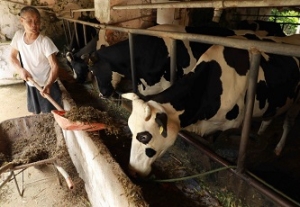Economic - Markets
Could Milk Go to $30, Dairy Economist Weigh in about the Dynamic Market

USDA reported that more than 297,000 dairy cows were culled in March, a decline of 5,000 year-over-year, but also an increase of more than 30,000 from February.
Ag economist Dan Basse, president of Ag Resource Co., says while the milk price is going towards a record high on a Class III basis, the feed cost and labor side of the equation is a rising challenge.
“I think the big question for the dairy markets going forward is will there be a continued reduction in the herd or liquidation,” Basse says. “If that happens, then milk prices need to be higher in the third and fourth quarter, but we're still waiting for that data to come forward.”
He shares that the biggest current concerns facing producers is forage and feed inventories. Basse says cull rates decline seasonally with grass availability and bottoms out around the fourth of July. However, with hay seedings at their lowest level since 1907, the economist says the drought in the western U.S. will also be closely monitored.
Bryan Doherty of Total Farm Marketing says the takeaway on higher culling numbers is that producers are understanding both high feed costs, as well as elevated cull cow prices.
“The dairy producer, like any other business right now, is facing significant uncertainties. Supply uncertainties, demand uncertainties, and you've got record-high dairy prices that are probably going to stick around and last longer than usual,” he says. “The dairy industry has a strong tendency to cure high prices through overproduction.”
Record High Milk Price?
Basse says that the dairy dynamics are not only domiciled in the U.S. but also felt globally.
“When I look at Oceania, which includes New Zealand and Australia, and when I look at Europe, dairy farmers are reacting the same way in both of those countries,” Basse says. “This provides the opportunity for the U.S. to service more world demand going forward.”
If milk production per cow output remains relatively steady, the milk market follows suit. Basse says if it increases, then we’re looking at the market around $22-$26/cwt. However, if it goes lower, then we could see all-time highs.
“Maybe as high as $29 or $30,” Basse adds.
All eyes will be watching what the dairy cow herd does, if there are continued liquidations due to grain prices moving higher, then the milk market could again follow suit.
“I think there's some uncertainty with how we get the crop in the ground and where we all sit come July and August,” Basse says.
Doherty agrees, sharing the equation has many variables, such as the value of the rising dollar and consumer demand to name a few.
“The biggest problem that we might see with the dairy industry is a dairy producer is uncertain about their inputs because of tight supplies and where they're going to get these inputs if there's a weather market. And there's a cost to expanding the herd,” he says.
Producers are cautious about expansion, questioning how they can expand their business without the needed labor to do so.
“Finding enough labor that's consistent and helpful is a big concern,” Doherty says.























